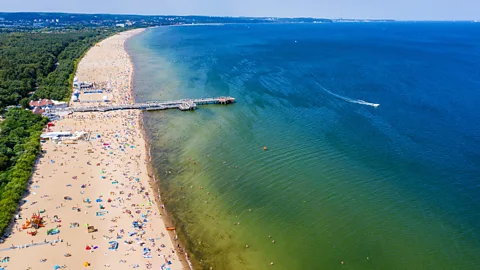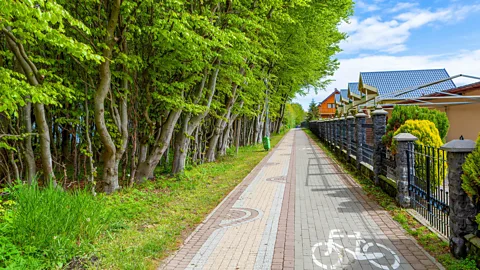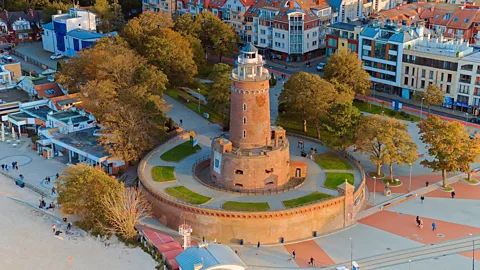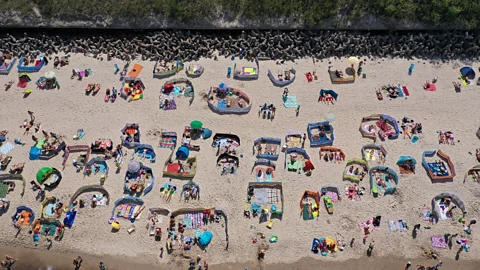Europe’s ‘underdog leader’ in slow-travel biking
6 min read4 hours ago
By Pavlo Fedykovych,
 Getty Images
Getty ImagesThe glorious Velo Baltica cycling route along Poland’s windswept Baltic Coast takes in endless dunes, romantic windmills, historic Hanseatic towns and abandoned forts.
February isn’t the most popular month to cycle along Poland’s windswept and broad Baltic Coast. In fact, the roadside display counting passing cyclists showed just “12” as I rode past. The weather was unwelcoming and chilly with thick clouds covering the sky. But that didn’t matter to me. I’d long wanted to come back to this region as it’s home to one of my favourite cycle routes in the country. When the forecast showed no rain or snow, I took my bike and jumped on the train from Krakow to hit the road.
While destinations like the Netherlands, Belgium and Denmark usually get all the biking fame in Europe, Poland’s devotion to building efficient cycling-exclusive routes has made it one of the underdog leaders of this kind of travel. Velo Baltica, also known as the R-10 trail, is a glorious route that spans more than 230km of coastline in Poland’s West Pomeranian Voivodeship region, starting at the border town of Świnoujście next to Germany and terminating in Ustka, taking in endless dunes, romantic windmills, a wide expanse of the Baltic Sea, historic Hanseatic towns and abandoned forts along the way.
It’s the epitome of slow tourism, ideal for unhurried riding while enjoying pastoral landscapes and feeling the Baltic breeze. And it’s family-friendly, flat and accessible, making it a hidden gem of European slow-travel biking escapes.
The trail is a dream come true for nature and history buffs – and you’ve got freedom to explore it all at your own pace. In Świnoujście, you’ll cycle next to the mighty 19th-Century Prussian coastal Gerhard Fort and can stop at the labyrinths of an Underground City, a complex of seven bunkers from the 1930s. The route will take you through the spectacular Wolin National Park with a bison reserve and the highest coastal cliffs in Poland. You can stop at the scenic ruins of a medieval Gothic church on a cliff near the beach in Trzęsacz; while the observation platform of the 45m-high octagonal Niechorze Lighthouse serves as a perfect viewpoint over the expansive Baltic dunes.
 Getty Images
Getty ImagesThis time, I’d chosen to ride a 35km section of the Velo Baltica from Kołobrzeg to Mielno.
Hit the trail
Both Świnoujście and Kołobrzeg are served by rapid Intercity trains and have daily connections to Warsaw, Krakow and Poznan.
Velo Baltica is fairly easy and doesn’t require much preparation. The route has an almost uninterrupted dedicated cycling lane with signage and various facilities, including resting stations, self-service repair points and tourist information desks. There’s plenty of accommodation along the way for every budget. You can either brave the whole length of the route or choose between its most picturesque sections.
The trail is open year-round but late spring is your best pick with Baltic nature in full bloom and fewer crowds on the beaches.
Everyone has their reasons for long-distance cycling, and my reason for hitting the road is the search for inner peace. I find biking very meditative and soothing, and this segment – with its perfect combination of natural and historic attractions – is my best therapist.
Here, the cycle path is mostly right on the beach’s edge so you can literally feel, hear and taste the grandeur of the Baltic Sea; a sort of prolonged meditation with the sounds of nature setting the soothing rhythm.
Kołobrzeg is a sleepy town that turns into a vibrant seaside resort during the summer. As I started my journey in this quintessential Polish coastal destination, I passed a long promenade filled with hotels and restaurants, a 26m-high red-brick lighthouse, and the gorgeous Gothic Cathedral Basilica. All these attractions have been restored to their original glory after the town was almost entirely destroyed during World War Two; West Pomeranian Voivodeship only became Poland in 1945 after centuries under German rule as a part of Prussia.
Some may find the greyness depressing, but I found it alluring. Wherever I looked, the panorama was reminiscent of the moody paintings of the Flemish masters. As I exited the Kołobrzeg town limits, a wooden bridge took me over the swampy beauty of the protected Eastern Ekopark with bogs and submerged trees. In 2010 the bridge was swept away by the melted waters from the spring thaw and the dune embankment was ruptured. Although the bridge and embankment were subsequently rebuilt and strengthened, the event showed how fragile this land is.
 Getty Images
Getty ImagesI continued on to the neighbouring resort towns of Sianożęty and Ustronie Morskie, where I stopped for a coffee on the pier. Every popular Polish Baltic resort town has a pier or molo. The longest, in the seaside city of Sopot, measures some 500m in length. While Sianożęty can’t compete with that, its delightful wooden pier offered a great vantage point of the local beaches.
The typical Baltic beach is vast, sandy and windy. In summer, Sianożęty and Ustronie Morskie are packed with hundreds of vacationers, mostly from across Poland. At this time of year, you’ll be sure to see a very characteristic thing for Polish beachgoers: lots of parawan plażowy (windbreaks). At high season, these multicoloured cotton screens, along with umbrellas and tents, take over every Polish beach so you can barely see the sand. They are part protection from the strong winds, part privacy – and, most importantly, an indication of a symbolic “ownership” of a piece of land. The tradition’s roots go back to the communist post-war Polish People’s Republic where proprietorship wasn’t allowed. While more and more Poles (especially young people) see the act of “windbreaking up” in bad taste, old habits die hard and the parawanrefuses to go away.
 Getty Images
Getty ImagesFinishing my coffee, I continued on my journey, riding through the thick beech forest of Ustronie Reseve where ruins of four artillery batteries and a control tower from the 1950s were hidden among the trees. The eerie military structures were part of a coastal defence until their abandonment in 1979 due to a strategy shift. As I cycled on, the paved trail turned into a gravel road and the forest landscape gave way to meadows.
In the village of Gąski, I stopped next to another imposing red-brick lighthouse. Constructed in 1877 and untouched by the war, it stood as a silent sentinel to days long gone. I climbed the 190 steps to its observation platform to admire the epic coastal panorama: the melancholic dance of the fields, forest and sea, all in various shades of winter grey.
From Gąski, the road turned inland for a while, passing through a residential area where almost every building was a guesthouse, until I once again met the music of the waves in the tranquil resort village of Sarbinowo. The route passed another pre-war architectural treasure: the beautiful 1856-built Neo-Gothic Church of the Assumption of the Holy Virgin Mary that romantically overlooks the beach promenade.
I arrived in Mielno, my terminus, just in time for a late lunch. The town is a lovely combination of 19th-Century wooden villas, Socialist-era resort complexes and ultra-modern new seaside hotels. Despite the winter season, Mielno was busy with people enjoying the sea views and taking long boardwalk strolls. As I feasted on żurek (fermented rye soup) and pierogi ruskie (potatoes and cottage cheese-filled dumplings) at a local restaurant, I was already planning my return trip in the summer.
Slowcomotion is a BBC Travel series that celebrates slow, self-propelled travel and invites readers to get outside and reconnect with the world in a safe and sustainable way.




